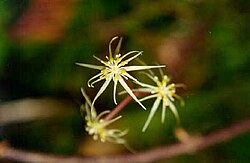| Coptis | |
|---|---|
 | |
| Coptis occidentalis flowers | |
| Scientific classification | |
| Kingdom: | Plantae |
| Clade: | Tracheophytes |
| Clade: | Angiosperms |
| Clade: | Eudicots |
| Order: | Ranunculales |
| Family: | Ranunculaceae |
| Subfamily: | Coptidoideae |
| Genus: | Coptis Salisb. |
| Type species | |
| Coptis trifolia | |
| Species | |
See text | |
Coptis (goldthread or canker root) is a genus of between 10 and 15 species of flowering plants in the family Ranunculaceae, native to Asia and North America.









